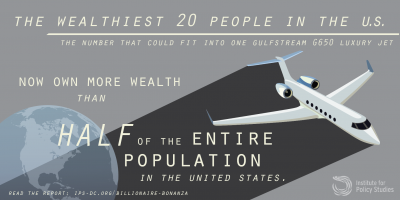US wealth inequality continues and has reached the level where 20 Americans are now worth as much as half the population. The 400 richest own as much as the bottom 61%. The 20 fit on a bus. The 400 fit in a restaurant. While the data may seem extreme, the estimate is considered to underestimate the inequality because, while the wealth of the bottom 61% is relatively easy to track, the wealth of the wealthiest may be greater if off-shore holdings and loopholes could be accounted for. A majority should hold authority in a representative democracy, but change is hindered by the role wealth plays within the political parties.
(Click on the infographic for the link.)
 “Billionaire Bonanza” -Institute For Policy Studies
“Billionaire Bonanza” -Institute For Policy Studies

It’s worth reading the original article which gives a nice compilation of potential interventions. In addition, we might improve our understanding of wealth inequality issues by looking at them from two other angles:
1. Aspiration. Not all individuals and/or families have goals involving accumulation of either physical/real wealth or financial (on the books) wealth. They value social interaction, artistic expression, contact with nature, for example, more than “being rich” or controlling assets. The wealth distribution problem might respond to very different solutions if we measure wealth in terms of personal aspirations, sense of satisfaction, happiness and achievement of personal goals rather than financial ledgers. This is not to say that we should ignore a strict financial analysis but that we should broaden our approach.
2. Opportunity to consume. Wealth concentration is a problem because
a) the wealthy few cannot consume enough to fuel industrial production of real goods and thus dampens productivity and
b) lack of access to money prevents those who wish to consume from obtaining the output of our industrial production engine thereby slowing down the whole economy.
In other words, neither a level playing field (equal opportunity) nor radical redistribution (equal outcome) are likely to maximize global satisfaction. Effective interventions will embody the maxim “different folks, different strokes” and will encourage individuals to address seriously the question of what they want out of life when they have both the freedom and opportunity to choose.
LikeLike